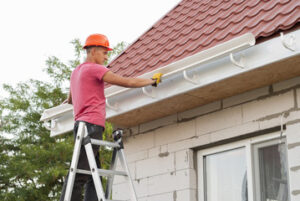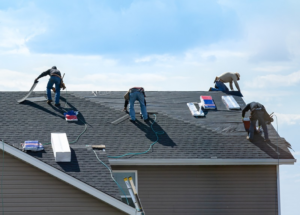Home » Posts tagged 'gutter cleaning'
Tag Archives: gutter cleaning
DIY vs Professional Gutter Cleaning Which Is Better?
Gutters And More Gutters cleaning is an important part of home maintenance. Some homeowners choose to undertake this task themselves, while others enlist the help of professionals. The choice between DIY and professional services involves a comprehensive assessment of costs, including the value of time and safety.
Considerations include your comfort level with heights and manual labor, available tools, and scheduling flexibility. This article will explore the pros and cons of each approach to help you decide which is best for your situation.

Cost
Gutter cleaning isn’t the most enticing home maintenance task, but it’s an essential part of maintaining a safe, healthy property. It prevents costly roof damage, reduces the risk of pest infestations, protects foundations, and maintains the aesthetic of a house. Many homeowners choose to undertake the task themselves rather than hire professional services. This decision is often based on budget, personal comfort with heights and manual labor, and the availability of time to dedicate to the project.
When considering DIY gutter cleaning, it’s important to weigh the pros and cons carefully. The most compelling advantage is cost savings, as homeowners may be able to purchase or rent the tools needed for the job at a lower price than hiring a professional. This can be especially attractive for those with limited budgets. However, the cost of equipment can add up quickly, particularly if one needs to purchase or rent ladders, work gloves, a hose, and any specialized tools.
Another disadvantage of DIY gutter cleaning is the potential for safety hazards, particularly for individuals who are not comfortable working at heights or lack the proper equipment. Falling from a ladder is extremely dangerous, and can be fatal. It’s also easy to miss spots when cleaning, which can lead to clogs and other problems down the road.
Finally, DIY cleaning can take a lot of time and requires the availability of a day off from work to complete the project. This can be challenging for those with busy schedules, and may not be the best option if one is looking for a quick fix to avoid expensive water damage. Professionals, on the other hand, offer expertise and efficiency and can provide peace of mind knowing that the job has been done correctly and safely. They can also address any underlying issues that may be contributing to a clogged or damaged gutter system.
Time
Gutter cleaning is a tedious chore that many homeowners are reluctant to undertake. However, the task is crucial to keep your home healthy and protect it from costly water damage.
To clean your gutters, you need time, a ladder, work gloves, buckets, and a hose or power washer. It is also important to ensure your safety by wearing sturdy work boots, using a ladder stabilizer or stand-off, and being comfortable working at heights. The process can take up to several hours depending on the size of your home and how well you clean.
Another advantage of DIY gutter cleaning is that you can work on your own schedule. You can choose when and how long to work, which can be a positive for those who enjoy this kind of physical labor. Moreover, some people find that doing something themselves can give them a sense of pride and satisfaction.
The disadvantage of DIY gutter cleaning is that it can be dangerous, especially if you don’t have the proper equipment or experience. You can fall from a ladder and sustain serious injuries. In addition, you may miss some parts of the house or gutter system due to lack of access. Additionally, if you don’t know how to spot clogs or other problems, it can be difficult to fix them.
Professional gutter cleaners have the right tools and training to do a thorough job. In addition, they can identify issues and offer preventive maintenance to keep your gutters in good condition. They can also save you money in the long run by preventing expensive repairs and other issues caused by neglected gutters.
Hiring professionals may cost more upfront than DIY, but it’s worth the investment. It provides peace of mind and a comprehensive service that can help you avoid costly repairs in the future. Besides, it can prevent costly water damage and other issues that may lead to structural damage and mold growth. It can also make your home more attractive. If you’re not convinced, consider the value of your time and the health of your home before making a decision.
Safety
Gutter cleaning is a necessary part of home maintenance, but the decision to DIY or hire a professional comes down to personal preference and available resources. Many homeowners choose to take on the task themselves, drawn by cost savings and the satisfaction of hands-on home maintenance. However, a successful and safe DIY gutter cleaning venture requires careful assessment of the job and the individual’s capabilities.
In the case of clogged gutters, neglecting the job can lead to severe issues such as water damage, mold build-up, and pest infestations. By removing leaves, twigs, and other debris, regular cleaning prevents blockages and keeps gutters functioning properly. In addition, the hands-on nature of this type of work allows homeowners to closely inspect their home and gutter system for issues that can cause significant damage if left unattended.
It’s important to note that DIY gutter cleaning requires the use of a ladder, which poses a potential risk of injury or property damage. It’s also crucial to wear gloves and safety glasses during the process. Furthermore, a ladder must be stable and secure, and it’s recommended to take frequent breaks to rest and stretch.
A professional gutter cleaner has specialized tools and safety equipment that can help ensure a quality, safe, and thorough job. They are trained to work safely at heights and typically come insured, which removes the burden of liability from the homeowner. In addition, they can clean gutters more quickly and efficiently than most DIYers, saving time and energy.
The main drawback of hiring a professional is that they cost more upfront than DIY services. However, the long-term benefits of having a clean, working gutter system outweigh the initial investment. In addition, professional gutter cleaners can identify and alert homeowners to issues that may require extensive repairs if ignored, saving money in the long run.
Availability
Gutter cleaning is a time-consuming and physically demanding task that requires the use of ladders and potentially hazardous tools. It is also a job that must be performed regularly, at least twice a year. Hiring professionals can help homeowners save their valuable time and energy, allowing them to spend their free time on other important tasks or even rest and relax. Furthermore, hiring professionals guarantees a swift and effective job, sparing homeowners from the recurring hassle of DIY gutter cleaning.
Many people gain a sense of accomplishment, satisfaction, and pride from taking on home maintenance tasks themselves. However, when it comes to gutter cleaning, there are several factors that should be considered before deciding whether DIY is the right option. The cost savings, potential safety risks, and subpar results should all be considered before making a decision.
DIY gutter cleaning involves the purchase of specialized equipment such as ladders, gutter scoops, and gloves, which can be expensive. It also requires a certain level of comfort with heights and the ability to perform physically challenging tasks. Professional gutter cleaners are experienced and trained in working from ladders, and they have the proper equipment to ensure a safe and efficient job.
While some individuals may find DIY gutter cleaning to be a viable option, it is important to consider the safety risks and time commitment involved. The job can be very dangerous if not done properly, and it is highly recommended that homeowners seek professional assistance to avoid the potential consequences of an ineffective or unsafe cleaning.
Homeowners often struggle with the decision of whether to hire a professional or tackle the job themselves. While DIY can be less expensive, it is usually more time-consuming and dangerous than professional services. Professional gutter cleaning offers a higher price tag, but it provides expertise, peace of mind, and convenience. It is important to weigh the pros and cons of each option before making a decision. In the end, it comes down to your budget, skill level, and comfort with performing risky tasks. Ultimately, it is worth the extra expense to prevent future damage and costly repairs to your home.
